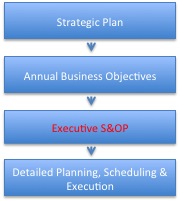LinkedIn recently reminded me (and my contacts) that I’d had a work anniversary. For the last two years I’ve been providing business operational consulting services as part of the Stratford team. The reminder made me reflect on my experiences with clients from a variety of business sectors.
The most striking observation from my consulting work is the surprising lack of supply and demand planning being performed in both mature companies and start-ups.
Considered a best practice in operations management, supply and demand planning is commonly referred to as “Sales and Operating Planning (S&OP)”. It’s an integral part of a disciplined corporate planning process that begins with a Strategic Plan and culminates in execution.
Best in class organizations embrace the S&OP process to provide an operational blueprint to match supply (products or services) and demand (sales). Done properly, it yields improved product delivery along with accelerated cash flow and inventory velocity. A less obvious benefit is that the entire company becomes aligned around operational strategy and execution.
Imagine an organization where everyone understands the targets, resource plans, risks and opportunities, key decision points and timelines. Nobody should ever be caught off guard.
Unfortunately, in my experience, this type of planning is more commonly done through ad hoc discussions, on the back of an envelope in the CEO’s office or by a planner making decisions that materially impact company resources without the benefit of all pertinent information.
Often there are even two sets of numbers floating around the company – the one the CFO is using and the other set that will really happen.
Check around. If you have two (or more!) sets of forecasts in your company, it’s time to instill the discipline of a Sales and Operating Plan. The improved results and business momentum gained from this best-in-class management practice will help you avoid unpleasant surprises, while building a culture of proactive management and engagement.
This article was published more than 1 year ago. Some information may no longer be current.


